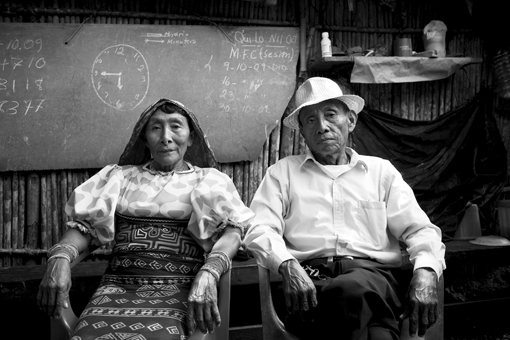Early one morning last October, my husband and I boarded a small 20-seater plane in Panama City and headed to Usdup, a village in the Kuna Yala archipelago. The fog was receding through mountain valleys as the sun peeked over the horizon. Only 45 minutes northeast of the capital, this island was a world away. To our north was a seemingly never-ending row of thatched roof huts, and beyond, the Caribbean Sea; to our south, the mainland, densely forested, covered by mangroves, banana trees and coconut palms. But this tropical paradise is also being overtaken by the effects of climate change.
Usdup has a population of about 5,000 people. As we walked through its maze-like footpaths with Toyo, a young Kuna man who took us in a cayuco (dugout canoe) half-way around the island to the only hotel in the village, it was easy to get a sense of how densely populated the place really was. The locals, mostly fishermen and subsistence farmers, lead busy social lives, conversing with neighbors and extended family as they swing in the hammocks hung between their houses, or going to the nightly congreso, the traditional town hall meeting. “Everyone here makes a living from nature, and each family has a small parcel on the mainland where they can grow coconuts, manioc, cocoa, yucca, corn, and bananas,” said Toyo, who works for the local airline that services the archipelago. “I’ve lost the custom of heading out each morning to harvest; but when I was a kid, I would always go in the cayuco to help my father.”
As he spoke, Toyo’s kids sat in front of a TV set (one of only about a dozen in town) watching cartoons. They too were losing their Kuna ways, Toyo lamented. But despite a few modern-day distractions and comforts, the lives of most residents of Kuna Yala are shaped by their proximity to the sea and the cycles of nature.
And that is precisely what now puts them at risk. Changing climate trends now seriously threaten the Kuna way of life. In November and December of 2008, abnormally high tides and persistent heavy rains flooded a majority of Kuna Yala’s small islands, ruining their subsistence crops, wood and straw huts and schools.
During our visit last October, Usdup’s foot paths became calf-deep little rivers after each downpour. Eventually the waters receded, exposing the landfill (that covers about 40 percent of the island) atop which locals live. They have been covering and treating the same land regularly for the past five years with gravel from the beds of nearby rivers.
Deities and Displacement
Studies by the Smithsonian Tropical Research Institute from 2008 show that since 1910, the average sea level in Kuna Yala has risen by almost six inches, and it’s continuing to increase by around three-quarters of an inch each year. All the islands sit slightly above sea level, and researchers estimate that at this rate they will be under water in the next 20 to 30 years. In addition to rising sea levels, climate change brings with it an increased risk of diseases such as malaria and dengue fever, higher incidence of drought, more extreme storms and hurricanes, and changes in the biodiversity on which they stake their livelihoods. So far, only the rains and tides have affected the Kuna way of life—a warning of more challenging times ahead.
Environmental conservation isn’t a new concept to the Kuna. Primary forests are considered bonigana, or spirit sanctuaries, which may not be cleared of their vegetation for fear that the spirits will unleash a wave of disease against the transgressors. Kuna mythology says that when the male deity Bab Tummat created the world, it was just deserted land until he decided to populate it with human beings who would be rooted deeply into the ground.
Originally from the Gulf of Urabá region in Colombia, the Kuna have lived in the border region between Panama and its eastern neighbor for centuries, since before the Spaniards arrived. By the mid-nineteenth century, entire Kuna villages relocated to the current archipelago, near the mainland forests and its rivers.
Now, the Kuna have been warned they will have to move the majority of their communities to the mainland in coming generations if they want to preserve their culture, religion, environment, economy and history. “…can you imagine how difficult that would be?” said Toyo. “And how would we pay for it?” The Panamanian government has discussed the need to help the Kuna with the transition in the next 10 to 15 years, but the nature of this help hasn’t been defined, nor has its cost.
In what may be an indication, last year, the small coastal village of Newtok in Alaska voted to move 350 people inland due to large waves and floods caused by climate change. The U.S.Army Corps of Engineers has estimated the move would cost more than $130 million. In the case of Kuna Yala, a similar effort would need to assist 10 times as many people, and factor in not only the cost of rebuilding homes, schools and clinics, but also road, electrical and water systems infrastructure.
Representation Without Recourse
Whatever happens, the Kuna people are sure to have a say in their future. Kuna Yala has a form of selfgovernance that is unique among indigenous communities in Panama. The comarca of Kuna Yala was established in 1938, after more than a decade of negotiations with Panama’s central government. The negotiations were sparked by a violent rebellion in February 1925, when Usdup native, Nele Kantule, and dozens of his fellow community members traveled by cayuco to the Kuna islands of Tupile and Ukupseni
and attacked the abusive Panamanian police stationed there to subjugate the Kuna. The confrontation left 27 people dead and drove the state police from the area.
Their hard-won new status allowed the Kuna people full voting rights in Panama along with territorial autonomy and final say over their resources and development. To this day, the Kuna have prevented foreigners from investing in resorts and tourism ventures on their islands; and all development or infrastructure projects must get consent from the Kuna leadership.
The Kuna General Congress, their highest government body, is represented at the Panamanian government level by three caciques, or chiefs, who are elected among the local communities. The Congress sits twice a year in Kuna Yula with five delegates from each of the comarca’s 48 communities, which in turn meet on a nightly basis to discuss issues and vote on them. Almost 85 years later, this democratic form of government gives the Kuna the greatest degree of self-rule of any indigenous group in Latin America, while helping them to keep their culture, and their relationship to the islands close to intact.
“Other indigenous groups around the world have fought very hard to keep their land and their traditions, but haven’t been as successful as we have,” said Toyo’s friend, Feliciano Jones, a gentle 70-year-old who lived in Panama City for 15 years, but returned to his plot of land and a simpler life. “We come from a tradition where the cacique often says: ‘Who said we are tired of being Indians? We will only stop being Indians when Bab Tummat calls us to go join him above.’”
Their revolutionary spirit has been much in evidence over the past 30 years. The Kuna have successfully fought mining concessions, plans to build a major highway, and other infrastructure projects that threatened their rights over their land and forests. Recently, the elders, or sahilas, have been meeting at nightly congresos to debate a proposal to extend an electric power line that starts in Colombia and would pass through Kuna territory in order to supply the rest of Panama and even other parts of Central America.
On our last evening in Usdup, Feliciano and Toyo met us at sundown inside the enormous thatched roof congreso. While dozens of people sat around on the aged wooden benches, the sahila was reciting Pab’igalas, metaphorical songs about the Earth, its resources, and its sacredness in Kuna culture that are passed down from generation to generation. “Do you know why the bird raises its head towards the sun each time he swallows?” said Toyo in my ear, translating the sahila’s words. “Because he’s thanking Bab Tummat for giving him food and drink.” The sahila went on: “The Kuna should learn from the bird, and be humble, and thank Bab Tummat for our food and water each day.”
As we sat inside the congreso, listening to the sahila’s songs, the sky grew dark and another tropical downpour began. We began to hear the people running and splashing around, looking for cover. The debate over their move into the mainland is now an important part of the nightly congreso discussions. Within the year, Kuna leadership will have to reach a final decision. For the Kuna people, the rains are another reminder of the fragility of their livelihood and culture.





